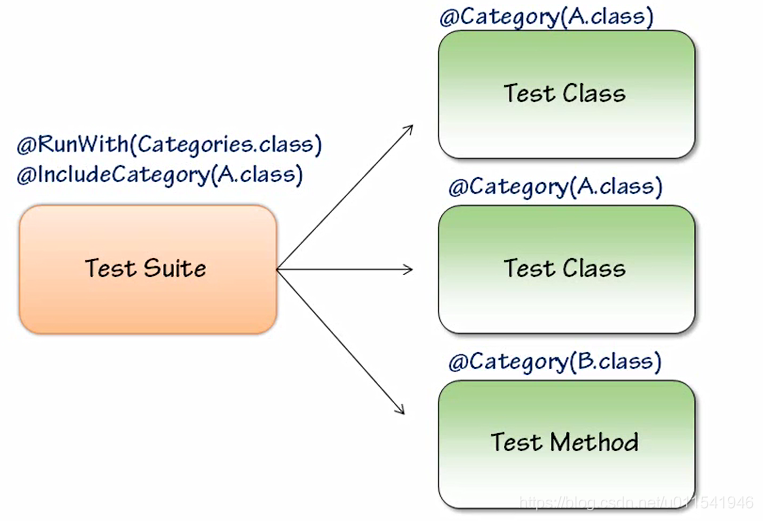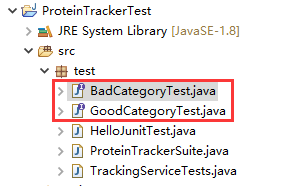本文主要是介绍Junit入门到掌握-10-JUnit高级-Categories,希望对大家解决编程问题提供一定的参考价值,需要的开发者们随着小编来一起学习吧!
前面介绍了测试套件TestSuite的概念和基本功能是把需要测试的测试类加进来管理,像一个容器一样。这样管理方式有些简单粗暴,为了达到更精细和灵活管理,我们这篇来学习一个Categories的概念,字面意思就分类。
1.Categories
这个分类和测试套件很像。

第一个特点,在TestSuite原来的注解变了,第二个我们需要在原来的TestClass里面是有Catogories注解。category既可以作用在方法,也可以作用在类上,我们习惯写在class 名称前一行,写在方法前一行不常用,一般一个class,我们做一个类型测试,一个业务场景类型。
2.Category demo练习
我们有两个测试类,我们把HelloJunitTest.java分类成A.class, 把PreteinTrackingTest.java分类成A.class, 只把前面文章写过的Timeout这个用例注释为B.class, A.class表示成功的用例集合,B.class表示失败的,A B都是接口。
搜先,我们需要提前创建一个Catogory的一个接口,用来后面分类使用,这个就是A.class
注意,这是一个接口,目前我们这个接口什么代码都不写。
package test;public interface GoodCategoryTest {}
然后创建一个BadCatoryTest接口
package test;public interface BadCategoryTest {}

然后开始使用Category注解在测试类中标注
package test;import static org.junit.Assert.assertEquals;import org.junit.Test;
import org.junit.experimental.categories.Category;@Category(GoodCategoryTest.class)
public class HelloJunitTest {@Testpublic void test() {assertEquals(5, "Hello".length());}
}
来看第二个测试类,由于我需要把里面一个方法标注成B.class,所以只能每个方法上都添加Category注解。
package test;
import static org.junit.Assert.*;import org.junit.After;
import org.junit.AfterClass;
import org.junit.Before;
import org.junit.BeforeClass;
import org.junit.Test;
import org.junit.experimental.categories.Category;import com.anthony.protein.InvalidGoalException;
import com.anthony.protein.TrackingService;public class TrackingServiceTests {private TrackingService ts;@BeforeClasspublic static void before() {System.out.println("Before class, Onln Once");}@AfterClasspublic static void after() {System.out.println("After class, only once");}@Beforepublic void setup() {System.out.println("Before Method");ts = new TrackingService();}@Afterpublic void tearDown() {System.out.println("After Method");}@Test@Category(GoodCategoryTest.class)public void newTrackingServiceTotalIsZero() {assertEquals("Tracking service total was not zero", 0, ts.getTotal());}@Test@Category(GoodCategoryTest.class)public void whenAddingProteinTotalIsIncreaseByAmount() {ts.addProtein(10);assertEquals(10, ts.getTotal());}@Test@Category(GoodCategoryTest.class)public void whenRemovingProteinTotalRemainsZero() {ts.removeProtein(5);assertEquals(0, ts.getTotal());}@Test(expected=InvalidGoalException.class)@Category(GoodCategoryTest.class)public void testExceptionThrow() throws InvalidGoalException {ts.setGoal(-5);}@Test(timeout=20)@Category(BadCategoryTest.class)public void badTest() throws InvalidGoalException {for(int i=0; i < 1000000000; i++) {ts.setGoal(1);}
}}
这个时候TestSuite这样写
package test;import org.junit.experimental.categories.Categories;
import org.junit.experimental.categories.Categories.IncludeCategory;
import org.junit.runner.RunWith;
import org.junit.runners.Suite;
import org.junit.runners.Suite.SuiteClasses;@RunWith(Categories.class)
@IncludeCategory(GoodCategoryTest.class)
@Suite.SuiteClasses({ HelloJunitTest.class, TrackingServiceTests.class // 接着写其他被测单元测试类
})public class ProteinTrackerSuite {}
执行下这个TestSuite文件

这种场景,我们还可以利用取反策略来跑用例,这里我们的场景是只执行Good的测试用例,取反就是除Bad之外的,我们需要利用注解@IncludeCategory相反的作用的,叫做@ExcludeCategory,就是除...之外,测试套件注解这么写,也是可以达到上面一样的运行结果。
package test;import org.junit.experimental.categories.Categories;
import org.junit.experimental.categories.Categories.ExcludeCategory;
import org.junit.runner.RunWith;
import org.junit.runners.Suite;@RunWith(Categories.class)
@ExcludeCategory(BadCategoryTest.class)
@Suite.SuiteClasses({ HelloJunitTest.class, TrackingServiceTests.class // 接着写其他被测单元测试类
})public class ProteinTrackerSuite {}
也就是只执行类GoodCategoryTest这个分类的用例,我把测试套件改成只执行BadCategoryTest.class
package test;import org.junit.experimental.categories.Categories;
import org.junit.experimental.categories.Categories.IncludeCategory;
import org.junit.runner.RunWith;
import org.junit.runners.Suite;
import org.junit.runners.Suite.SuiteClasses;@RunWith(Categories.class)
@IncludeCategory(BadCategoryTest.class)
@Suite.SuiteClasses({ HelloJunitTest.class, TrackingServiceTests.class // 接着写其他被测单元测试类
})public class ProteinTrackerSuite {}
运行下

只执行这个标注为BadCategoryTest.class的用例,这个是期待的效果。
这篇关于Junit入门到掌握-10-JUnit高级-Categories的文章就介绍到这儿,希望我们推荐的文章对编程师们有所帮助!




